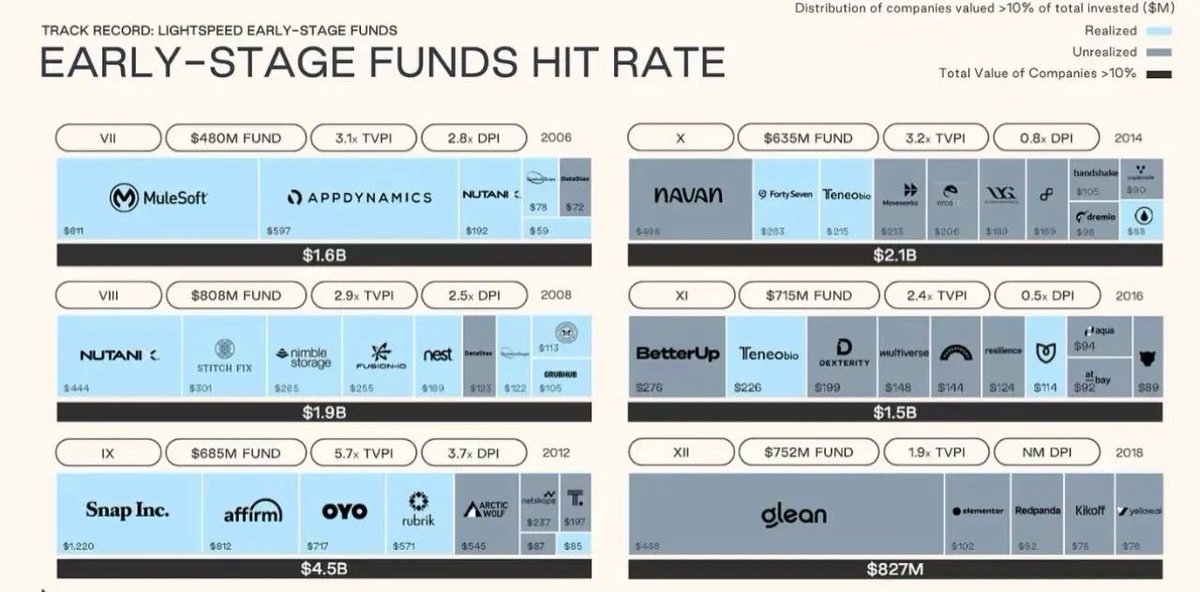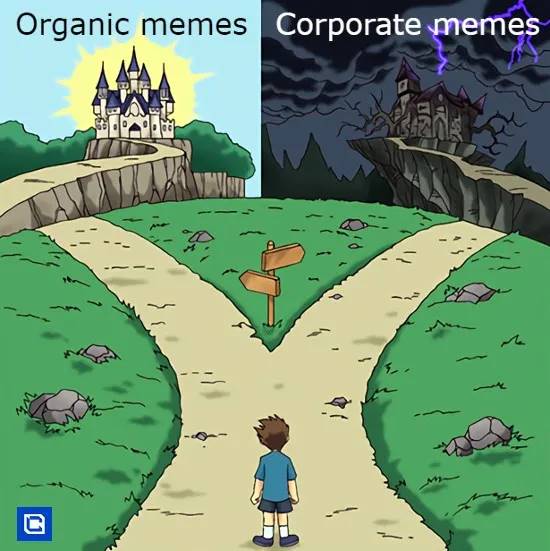Author: YetaS
The biggest feeling when I went to Consensus HK this time was that VC was too difficult. It would be impossible to say that there were countless sorrows and woes, which formed a strong contrast with Marshal P. Some VCs cannot raise the next round of funds, some VCs have left half of them, some VCs have switched to war investment instead of investing independently, and some VCs even consider issuing Meme to raise funds.……
Many VC colleagues have also chosen to leave, some joining the project side, and some transforming into KoL. It seems that these are all more cost-effective options. In the midst of changes, everyone is looking for a new way to survive. And I was also thinking, what happened to VC? How to break the situation?
First of all, we have to admit that the best times of VC as an investment asset class are over, whether in China and the United States.The following figure shows the return data of several phases of Lightspeed funds. The best fund invested in Snap, Affirm, and OYO in 2012 and achieved a return of DPI 3.7X (DPI is the assigned return multiple and does not rely on valuation and measures the actual withdrawal of funds).), of course, it is completely incomparable to buying BTC directly, and even recovering costs has become a problem since 2014.

China VC has experienced a similar trajectory. Relying on the demographic dividend, the rapid growth of mobile Internet and consumer Internet has given birth to hundreds of billions of enterprises such as Ali, Meituan, and Byte. 2015 was the last highlight moment. Subsequently, supervision became stricter, liquidity tightened, industry dividends declined, industrial cycle changes faced growth bottlenecks, and IPO exit channels were limited. As a result, the return rate of VC institutions dropped significantly and a large number of employees left the market.
Crypto VC is no exception. With the changes in the macro environment, the evolution of market structure and the decline in capital returns, VCs are facing huge survival difficulties.
It’s all about cost and liquidity
In the past, the value chain of VC investment was clearly visible: the project party brought innovative ideas, VC provided strategic support and resources, KoL amplified the market voice at critical moments, and finally completed value discovery at CEX. Everyone provides different values at different stages, assumes different risks, and obtains matching benefits. This is a relatively fair value chain.
For example, as VCs, the value we provide is never as simple as investing a sum of money in the early stages. How to help project parties connect key resources in the ecosystem as quickly as possible to promote business development, provide timely advice when the market trend changes suddenly, help project parties adjust strategies, and even help build core team building. Moreover, in order to make a long-term binding with the project party, let alone when TGE will be available, even after TGE, we usually face a one-year lock-in and 2-3 years of vesting. To a large extent, we all hope to go with the project party. Play a non-zero-sum game of PVE.
However, in the current market environment, the core contradiction lies in the extreme lack of liquidity, intensified market games, and the VC model is unsustainable.
Changes in capital flows: Where did VC’s dilemma come from?
The main driving force for this round of bull market is the strong entry of US Bitcoin spot ETFs and institutional investors. However, the transmission path of funds has undergone major changes:
-
Institutional funds mainly flow to BTC, BTC ETFs and even Index, but will never spread to the wider copycat market;
-
Without real technical/product innovation support, it is difficult for altcoins to maintain high valuations.
This directly leads to the VC model being highly FUD in the current market environment. Retail investors believe that VCs enjoy an unfair advantage, can obtain chips at a lower cost, and grasp key market information. This information asymmetry leads to the collapse of market trust and the further depletion of liquidity.In the PvP environment, retail investors demand absolute fairness.In contrast, the strategy of secondary funds will not have a strong opposition to market sentiment, because retail investors can also enter the market with the same chips. After all, they have given absolutely fair opportunities.
The current heinous Fud against VC is a counterattack against absolute fairness against relative fairness in the face of liquidity shortage.
The rise of Meme financing model
If I regarded Meme as a cultural phenomenon last time, then this time we need to regard it as a new way of financing. The core value of this financing method is——
-
Fair participation mechanism: Retail investors can track information through on-chain data and gain early chips under a relatively fair pricing mechanism;
-
Lower barriers to entry: During the DeFi Summer period, we supported many solo dev’s, who relied on product innovation to promote value capture. Now, the Meme model further lowers the threshold, allowing developers to have assets first and then products.
There is no problem with this logic in itself. Looking back, many public chains conduct TGE without a mature ecosystem or main network. Why can’t Meme use the same method to attract enough attention before promoting product development?
In essence, this path evolution of assets first and products later is the wave of populist capitalism sweeping across the entire financial ecosystem.The prevalence of the attention economy, catering to the public’s desire to get rich quickly, breaking the monopoly of traditional financial institutions, lowering the threshold for funds, and openness and transparency of information are all unstoppable trends in the new era of populism.GameStop retail investors vs. Wall Street, and the evolution of fundraising methods from ICO to NFT to Meme are all financial interpretations under the tide of the times.
So I say, Crypto is just a microcosm of this era.

The role of VC in the new model
No financing model is perfect. The biggest problem with Meme’s financing model is the extremely low signal-to-noise ratio, which brings unprecedented trust challenges.——
-
Very low signal-to-noise ratio: Fair launch makes the cost of asset issuance extremely low and will fill it with a lot of garbage.
-
Insufficient information transparency: For highly liquid Meme projects, everyone in the market can enter early, which means that whether the project is built for a long time has become less important. What matters is how to make profits in the game.
-
Trust costs soar: High liquidity means high game. The first day of circulation means that we have no mechanism to bundle interests with the Founder to achieve long-term win-win results. Everyone can become opponents at any time and become each other’s exit liquidity. This trust structure is dangerous and unsustainable.
I very much agree with @yuyue_chris’s writing about the differences in mindset among different participants:
People who play Meme think: narrative chip structure ~ community or emotional product technology;
The primary market believes that: narrative product technology ~ chip structure community or emotion;
Meme mode is essentially a darker world on the chain than VC mode. Due to the lack of product and technical support, absolute fairness is often just a cover.Look at Libra. Every carefully planned public benefit by the cabals behind the market ultimately makes us the target of precise harvesting. They can always predict your predictions. In a highly gamed environment, the real long-term Builder becomes difficult to distinguish.
I don’t think VC will disappear, because the world is full of huge information asymmetry and trust asymmetry. Cooperation resources such as ARC are never available to an ordinary Dev.
But in the face of such a wave of populist capitalism, VC still hopes to simply use information asymmetry as in the past to lay down and make money. It is unrealistic. Adapting to change is never easy, especially when the market paradigm is completely reshaped and methodologies that have worked well in the past are quickly eliminated. The rise of Meme Financing is not accidental, but the result of deeper liquidity changes and the reshaping of trust mechanisms.
When Meme’s high liquidity and short-term game thinking encounter long-term support and value empowerment from VC, how to find a balance between the two is a problem that VC must face at present。On the one hand, Primitive is grateful that it has the freedom and flexibility to cope with market changes, but it is not easy to recognize structural changes and change its investment strategy.
But no matter how the market changes, one thing that remains unchanged and truly determines long-term value is those outstanding founders who have vision, strong execution, and are willing to continue to build.
Welcome to join the official social community of Shenchao TechFlow
Telegram subscription group: www.gushiio.com/TechFlowDaily
Official Twitter account: www.gushiio.com/TechFlowPost
Twitter英文账号:https://www.gushiio.com/DeFlow_Intern



